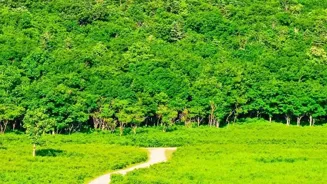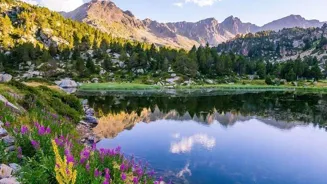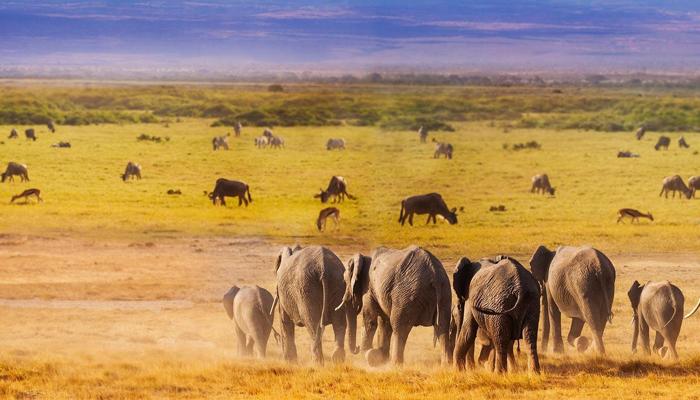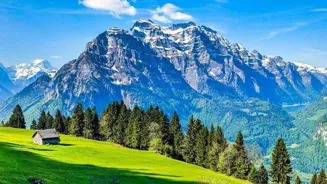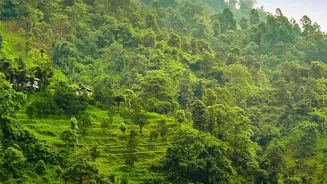Embark on a journey through India's breathtaking national parks, where nature's wonders unfold. From tigers in Jim Corbett to rhinos in Kaziranga, explore the beauty and diversity of these sanctuaries.
Read on to discover the magic of India's wildlife!
India, a land of vibrant culture and rich history, also boasts a stunning array of natural landscapes. From the snow-capped Himalayas to the lush green forests of the south, the country is a treasure trove of biodiversity.
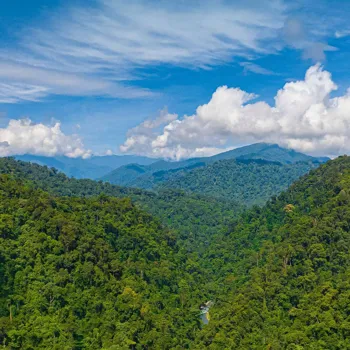
To protect and preserve these natural wonders, India has established a network of national parks, each offering a unique glimpse into the country's diverse ecosystem.
These parks are not just about wildlife; they are about experiencing the raw beauty of nature, breathing in fresh air, and connecting with the earth in a way that rejuvenates the soul.
Forget crowded cities and noisy streets; it's time to pack your bags and embark on a journey to explore ten national parks that will truly take your breath away. Get ready to witness nature's masterpiece unfold before your very eyes.
Jim Corbett National Park, Uttarakhand: A Tiger's Abode
Jim Corbett National Park, located in the foothills of the Himalayas, is India's oldest national park and a true haven for wildlife enthusiasts. Established in 1936 as Hailey National Park, it was later renamed in honour of the legendary hunter and conservationist, Jim Corbett.
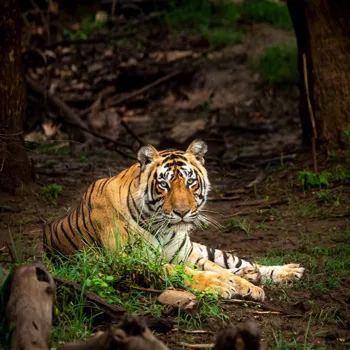
The park is renowned for its tiger population, but it also shelters a diverse range of other animals, including elephants, leopards, deer, and various species of birds.
Imagine yourself on a jeep safari, the crisp morning air filling your lungs as you traverse through dense forests and open grasslands. The adrenaline rush of spotting a majestic tiger in its natural habitat is an experience that will stay with you forever.
Corbett isn't just a park; it's a living testament to the importance of conservation, showcasing how humans and wildlife can coexist in harmony.
The park's landscape is as diverse as its fauna, with rolling hills, riverine belts, and large lakes adding to its scenic beauty.
The Ramganga River, which flows through the park, is a lifeline for the wildlife and provides stunning views for visitors. Birdwatchers will be delighted by the sheer variety of avian species, from colourful kingfishers to majestic eagles.
Corbett offers a range of accommodation options, from forest rest houses to comfortable resorts, catering to different budgets and preferences.
Whether you are a seasoned wildlife enthusiast or a first-time visitor, Jim Corbett National Park promises an unforgettable adventure filled with breathtaking sights and unforgettable experiences. Remember to book your safari in advance, especially during peak season, to avoid disappointment.
Respecting the park's rules and regulations is crucial to ensure the safety of both visitors and the wildlife.
Beyond the thrill of wildlife spotting, Corbett offers a chance to connect with nature on a deeper level.
The peace and tranquility of the forest, broken only by the sounds of birds and animals, can be incredibly therapeutic. Take a moment to simply sit and absorb the atmosphere, letting the natural beauty wash over you.
Many visitors also enjoy trekking and nature walks, allowing them to explore the park's hidden corners and discover its lesser-known treasures.
With its rich history, diverse ecosystem, and stunning landscapes, Jim Corbett National Park is a must-visit destination for anyone seeking an authentic wildlife experience in India.
It is a place where you can witness the power and beauty of nature firsthand, leaving you with a renewed appreciation for the importance of conservation.
Kaziranga National Park, Assam: Land of the One-Horned Rhino
Nestled in the heart of Assam, Kaziranga National Park is a UNESCO World Heritage Site and a global stronghold for the endangered one-horned rhinoceros. The park's vast grasslands, dotted with swamps and dense forests, provide the perfect habitat for these magnificent creatures.
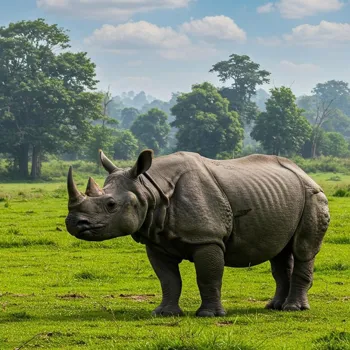
A jeep safari through Kaziranga is an adventure in itself, as you navigate through tall grasses and muddy tracks, hoping to catch a glimpse of a rhino grazing peacefully or a herd of elephants bathing in a waterhole.
The sheer density of wildlife in Kaziranga is astounding, making it a truly unforgettable experience for nature lovers. The park also boasts a healthy population of tigers, leopards, and wild buffalo, adding to its biodiversity.
Kaziranga is not just about rhinos; it is a birdwatcher's paradise, with over 480 species of birds found within its boundaries. From migratory birds like pelicans and storks to resident species like hornbills and eagles, the park offers a kaleidoscope of avian wonders.
The Brahmaputra River, which flows along the northern boundary of the park, adds to its scenic beauty and provides an important source of water for the wildlife.
Boat safaris on the Brahmaputra offer a unique perspective of the park and its inhabitants, allowing you to spot river dolphins and other aquatic animals. Kaziranga's success in rhino conservation is a testament to the dedication and hard work of the forest department and local communities.
Visiting Kaziranga is an opportunity to witness the positive impact of conservation efforts and to support the protection of this precious ecosystem.
There are many eco-tourism initiatives in the area that provide sustainable livelihood opportunities for local communities while promoting responsible tourism.
By staying in locally run guesthouses and engaging in community-based activities, you can contribute to the conservation of Kaziranga and its wildlife. The best time to visit Kaziranga is during the winter months (November to April) when the weather is pleasant and the visibility is good.
Remember to carry appropriate clothing and footwear for outdoor activities.
A visit to Kaziranga is not complete without experiencing the local Assamese culture. The region is known for its vibrant traditions, delicious cuisine, and warm hospitality.
Take some time to explore the nearby villages and interact with the local people to learn about their way of life. Sampling the local delicacies, such as momos and thukpa, is a must for any food lover.
Kaziranga National Park is not just a wildlife sanctuary; it's an immersive experience that combines nature, culture, and adventure, leaving you with lasting memories and a deeper appreciation for the natural world.
This park showcases the beauty of Assam and gives a great memory
to visitors.
Bandhavgarh National Park, Madhya Pradesh: Tiger Territory
Bandhavgarh National Park in Madhya Pradesh is renowned for its high density of tigers, making it one of the best places in India to spot these majestic predators.
The park's rugged terrain, with its rocky hills, dense forests, and sprawling grasslands, provides the perfect habitat for tigers and other wildlife. The name Bandhavgarh translates to "Brother's Fort," referring to an ancient fort located within the park.
The fort adds a historical dimension to the park's natural beauty, offering stunning views of the surrounding landscape. Jeep safaris are the most popular way to explore Bandhavgarh, allowing you to traverse through the park's diverse terrain in search of tigers and other animals.
The park is also home to a variety of other wildlife, including leopards, deer, sloth bears, and various species of birds. The dense vegetation provides ample cover for these animals, making wildlife spotting a thrilling and unpredictable experience.
Bandhavgarh is divided into several zones, each with its own unique characteristics and wildlife sightings. Tala zone is considered the most popular and offers the best chances of spotting tigers.
However, other zones like Magadhi and Khitauli are also worth exploring for their scenic beauty and diverse wildlife. Birdwatchers will be delighted by the variety of avian species found in Bandhavgarh, including eagles, vultures, and colourful birds.
To truly appreciate the beauty of Bandhavgarh, consider staying in one of the many jungle lodges and resorts located near the park. These lodges offer comfortable accommodation and provide a range of activities, including nature walks, birdwatching tours, and cultural experiences.
Interacting with local guides and naturalists can enhance your understanding of the park's ecosystem and the importance of conservation. Bandhavgarh is a place where you can witness the raw power and beauty of nature, leaving you with a renewed sense of respect for the wild.
Kanha National Park, Madhya Pradesh: Inspiration for "The Jungle Book"
Kanha National Park, also located in Madhya Pradesh, is another gem in India's wildlife crown. This park is famed as the inspiration for Rudyard Kipling's classic novel, "The Jungle Book.
" The park's sprawling grasslands, dense forests, and meandering rivers create a magical landscape that evokes the spirit of Kipling's stories. Kanha is renowned for its successful conservation efforts in preserving the endangered barasingha, or swamp deer.
The park also boasts a healthy population of tigers, leopards, wild dogs, and a variety of other wildlife.
A jeep safari through Kanha is an immersive experience, allowing you to explore the park's diverse ecosystems and spot its incredible wildlife.
The open grasslands provide excellent opportunities for viewing barasingha herds, while the dense forests offer shelter to tigers and other elusive creatures. The park is divided into several zones, each with its own unique characteristics and wildlife sightings.
Kisli zone is particularly popular for its scenic beauty and high tiger density. Birdwatchers will be impressed by the variety of avian species found in Kanha, including eagles, vultures, and colourful flycatchers.
Staying in one of the jungle lodges or resorts near Kanha is a great way to enhance your wildlife experience. These lodges offer comfortable accommodation and provide a range of activities, including nature walks, birdwatching tours, and cultural experiences.
Interacting with local guides and naturalists can deepen your understanding of the park's ecosystem and the challenges of conservation.
Kanha is a place where you can connect with nature on a profound level, immersing yourself in the world of "The Jungle Book" and witnessing the beauty and fragility of our planet's wildlife.
Periyar National Park, Kerala: Spice-Scented Wilderness
Periyar National Park, nestled in the Western Ghats of Kerala, offers a unique wildlife experience amidst spice-scented hills and lush green forests. The park is centered around the Periyar Lake, a man-made reservoir that provides a crucial source of water for the wildlife.
Boat safaris on the Periyar Lake are a popular way to spot elephants, deer, and other animals that come to the water's edge to drink. The park is also home to tigers, leopards, and a variety of other wildlife, although sightings are less frequent than in some of the other parks on this list.
Periyar is renowned for its diverse birdlife, with over 260 species of birds found within its boundaries. From colourful kingfishers to majestic hornbills, the park offers a feast for birdwatchers.
Trekking through the park is another popular activity, allowing you to explore the spice plantations and cardamom hills that surround the lake. The aroma of spices fills the air, creating a sensory experience that is unique to Periyar.
The park also offers opportunities for bamboo rafting and elephant rides, providing different perspectives of the park's beauty.
Staying in one of the eco-friendly resorts and guesthouses near Periyar allows you to support responsible tourism initiatives that benefit local communities.
Interacting with local guides and naturalists can enhance your understanding of the park's ecosystem and the importance of conservation.
Periyar is a place where you can connect with nature in a peaceful and serene environment, immersing yourself in the beauty of the Western Ghats and experiencing the spice-scented wilderness of Kerala.
Ranthambore National Park, Rajasthan: Royal Encounters
Ranthambore National Park in Rajasthan is a unique blend of wildlife and history, with its ancient fort adding a touch of royalty to the park's natural beauty.
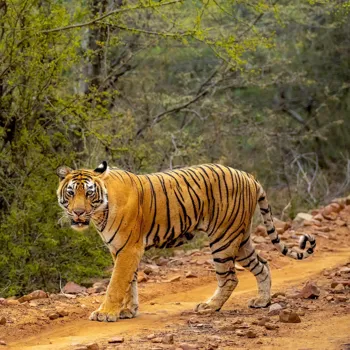
The park is renowned for its tiger population, and sightings are relatively frequent, making it a popular destination for wildlife enthusiasts. The landscape of Ranthambore is characterized by rocky hills, dry deciduous forests, and open grasslands, providing a diverse habitat for wildlife.
A jeep safari through Ranthambore is an adventure in itself, as you navigate through the park's rugged terrain in search of tigers and other animals.
The park is also home to leopards, deer, sloth bears, and a variety of other wildlife.
The ancient Ranthambore Fort, located within the park, offers stunning views of the surrounding landscape and adds a historical dimension to the wildlife experience.
Birdwatchers will be delighted by the variety of avian species found in Ranthambore, including eagles, vultures, and colourful kingfishers. The park is divided into several zones, each with its own unique characteristics and wildlife sightings.
Staying in one of the heritage hotels or jungle resorts near Ranthambore allows you to experience the royal hospitality of Rajasthan while enjoying the beauty of the park.
Interacting with local guides and naturalists can enhance your understanding of the park's ecosystem and the challenges of conservation. Ranthambore is a place where you can witness the majesty of tigers against the backdrop of ancient ruins, creating a truly unforgettable experience.
These parks each offer a diverse view of natural beauty.
These 10 national parks represent just a fraction of India's natural wonders. Each park offers a unique and unforgettable experience.
